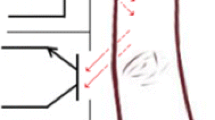Abstract
Pulse rates obtained from wearable photoplethysmography (PPG) sensors are important for monitoring cardiovascular condition, especially during exercise. However, it is difficult to precisely count pulse rates during exercise because PPG is sensitive to body movement. The artifacts from body movement are caused by a change in the blood volume at the measurement site, in addition to pulsatile changes. Here, we investigated the influence of motion artifact with respect to light source and anatomical sites. In this study, we compared the signal from green-light PPG to that from infrared PPG at different anatomical sites. In these experiments, 11 subjects were asked to either assume a resting position or generate spontaneous motion artifact by jumping and swinging their arm. As a result, pulse rates obtained from green-light PPG showed a higher correlation with the ECG R-R interval as compared to those obtained with infrared. Additionally, the signal from the upper arm showed less artifact than did the peripheral one. Therefore, the green-light PPG may be useful for pulse rate monitoring.








Similar content being viewed by others
References
Allen, J., Photoplethysmography and its application in clinical physiological measurement. Physiol. Meas. 28:R1–R39, 2007.
Kim, B. S., and Yoo, S. K., Motion artifact reduction in photoplethysmography using independent component analysis. IEEE Trans. Biomed. Eng. 53:566–568, 2006.
Hayes, M. J., and Smith, P. R., Artifact Reduction in Photoplethysmography. Appl. Opt. 37:7437–7446, 1998.
Yan, Y., Poon, C., and Zhang, Y., Reduction of motion artifact in pulse oximetry by smoothed pseudo Wigner-Ville distribution. J. Neuro Eng. Rehabil. 2:3, 2005. Open access.
Seyedtabaii, S., Seyedtabaii, L., Kalman filter based adaptive reduction of motion artifact from photoplethysmographic signal World Academy of Science, Engineering and Technology. 37 2008.
Hertzman, A. B., The blood supply of various skin areas as estimated by the photoelectric plethysmograph. Am. J. Physiol. 124:323–340, 1938.
Hertzman, A. B., Randall, W. C., and Jochim, K. E., Relations between cutaneous blood flow and blood content in the finger pad, forearm and forehead. Am. J. Physiol. 150:122–132, 1947.
Hertzman, A. B., and Randakk, W. C., Regional differences in the basal and maxima rates of blood flow in skin. J. Appl. Physiol. 151:234–241, 1948.
Tur, E., Tur, M., Maibach, H. I., and Guy, R. H., Basal perfusion of the cutaneous microcirculation: measurements as a function of anatomical position. J. Invetst. Dermatol. 81:442–446, 1983.
Allen, J., and Murray, A., Variability of photoplethysmograpy peripheral pulse measurements at the ears, thumbs and toes. IEE Proc. Sci. Measu. Technol. 147:403–407, 2000.
Kamal, A. A. R., Harness, J. B., Irving, G., and Mearns, A. J., Skin photoplethysmography—a review. Comp. Meth. Programs Biomed. 28:257–269, 1989.
Author information
Authors and Affiliations
Corresponding author
Rights and permissions
About this article
Cite this article
Maeda, Y., Sekine, M. & Tamura, T. Relationship Between Measurement Site and Motion Artifacts in Wearable Reflected Photoplethysmography. J Med Syst 35, 969–976 (2011). https://doi.org/10.1007/s10916-010-9505-0
Received:
Accepted:
Published:
Issue Date:
DOI: https://doi.org/10.1007/s10916-010-9505-0




